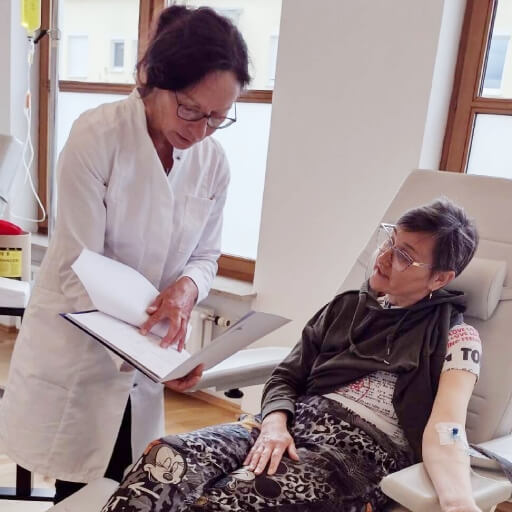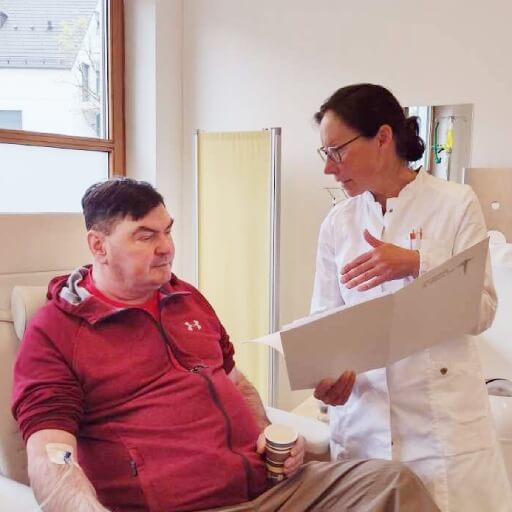Bone metastases often occur in the advanced stages of cancer, which are characterized by rapid spread beyond the tumor site and invasion of distant organs and tissues. Studies reported that approximately 350,000 people died from bone metastases in the USA alone, underscoring the devastating nature of this issue [1]. The highest incidence (30-50%) of bone metastases is found in prostate cancer patients, which raises concerns about the treatment strategy for this group [2].
Metastatic cancer is already overwhelming itself because it additionally affects an already compromised quality of life. In countries with poorly developed medicine, such patients are often given up and switched to symptomatic treatment, which is often ineffective. Mobility problems, pathological fractures, persistent annoying pain, and the inability to perform daily activities are just some of the challenges faced by patients with bone metastases. But even in this situation, there is hope for a better life. Innovative treatment options can help you live a pain-free life and bring back your relatively active daily routine. Doctors in Germany successfully cope with treating bone metastases and treating complications of bone metastases with external beam radiation therapy, radionuclide therapy, ablation, high-intensity focused ultrasound, immunotherapy, and other methods.
Origin and Symptoms of Bone Metastases
Metastasis in bones may occur with any type of cancer, but prostate cancer demonstrates the highest risk for bone metastases (over 50%), followed by breast cancer (about 40%) and lung cancer (about 33%) [3]. The main consequences of bone metastasis are as follows:
- Pain: torments a person constantly and periodically intensifies.
- Bone fractures: occur due to bone tissue demineralization.
- Spinal cord compression: occurs when cancer metastasizes to the spine; early symptoms include back or neck pain, followed by numbness in the legs and abdomen, weakness in the legs, and urinary and fecal incontinence.
- High blood calcium levels: calcium is released from destroyed bones, causing patients to experience symptoms such as constipation, muscle pain, drowsiness, thirst, and frequent urination. Renal failure may progress over time.
Conventional Therapy: Surgery, Radiotherapy, and Drugs
Surgery
A single bone metastasis that causes pain and risk of complications can be removed surgically. Despite being technically challenging, surgical treatment has specific indications and is a part of bone metastases treatment guidelines. With complete removal, local tumor recurrence is rare. Cirstoiu et al report that bone resection accompanied by bone reconstruction and/or with the subsequent endoprosthesis is a beneficial surgery to treat metastatic bone lesions in the long bones. Pathological fractures are also quite typical for such clinical situations, which is why a number of surgical interventions are performed to stabilize the bones. These include:
- Osteoplasty – the injection of bone cement to fix the bone
- Osteosynthesis – the implantation of fixing structures to stabilize the bone, thereby preventing fracture
- Vertebroplasty – a minimally invasive procedure for vertebral fracture treatment that involves the injection of bone cement into the area of the damaged vertebra
German doctors always prefer organ-preserving interventions, avoiding more uncomplicated but life-threatening mutilation surgery.

Radiation Therapy for Bone Metastases
External beam radiotherapy for metastatic cancer is the basis of standard treatment used for palliative purposes. This treatment method aims to relieve pain and improve the patient's quality of life. The method is effective to some degree in almost all patients. Six months after irradiation, 70% of treated patients still have no severe pain, and 35% have no pain at all. Additional effects of radiation therapy are as follows:
- Destruction of tumor foci
- Restraining their growth
- Restoration of the normal structure of bone tissue
Radionuclide Therapy
Radionuclide therapy involves the injection of radioactive substances that accumulate in the bones and suppress metastatic foci with radiation. This is a systemic modification of radiotherapy. Its advantage is that it targets all bone metastases at once. Over the past 20 years, radiopharmaceuticals have become more sparing and effective. They provide:
- Selective accumulation in metastatic foci
- Rapid elimination from healthy tissues
- High energy of radiation allows rapid destruction of metastases
- Minimal particle path length to avoid damage to bone marrow
For metastatic prostate cancer, doctors in Germany often use Radium-233 [4]. It attacks bone metastases with short alpha radiation that spreads only 0.1 mm. The radiopharmaceutical does not penetrate the tubular bones and does not have a pronounced effect on the bone marrow.
Drug Therapy
For the treatment of patients with bone metastases, not only local but also systemic treatment is essential. However, systemic therapy doesn't work right away. Until a therapeutic result is achieved, complications such as bone fractures may develop. Bone strengthening with osteomodifying agents is required to prevent complications. These drugs include:
- Bisphosphonates
- RANK ligand inhibitors (monoclonal antibodies)
These drugs are given immediately after bone metastases are diagnosed, regardless of whether the patient has symptoms.
Innovative Treatment for Bone Metastases
Dendritic Cell Vaccines
Cancer vaccines have long been a tempting dream for both scientists and patients. Today, patients from all over the world can undergo treatment with unique tumor-specific, personalized dendritic cell vaccines. Dendritic cells are part of the immune system responsible for presenting antigens to immune killers and initiating the elimination of malignant cells. Identifying these cells was a breakthrough in medicine and earned its discoverer, Ralph Steinmann, the 2011 Nobel Prize in Medicine [5].
Bone metastases are partly accounted for changes in local microenvironment caused by the tumor. Furthermore, secretion of specific substances helps malignant cells to evade immune-mediated elimination. Dendritic cell vaccines have the ability to modify tumor microenvironment so that hidden metastases become visible to immune killers and can be detected and eliminated by the patient's own immune system. Studies in osteosarcoma patients have shown that injections of dendritic cell vaccine led to tumor regression and a systemic immune response, resulting in tumor shrinkage. In addition, administration of dendritic cell vaccine in combination with chemoradiation improves disease control, halts progression and may improve progression-free survival rates.
Dendritic cell vaccines are actively used for the treatment of various types of cancer, including advanced stages with bone metastases. Some dendritic cell vaccines have even gained an FDA (US Food and Drug Administration) approval for the treatment of prostate cancer, which is an extremely high recognition of dendritic cell vaccination efficacy. Dendritic cell vaccines can be administered at any stage of the disease, and they are a perfect complementing method for bone metastasis treatment as part of a multidisciplinary approach. The procedure itself is well tolerated, time-saving and does not cause any serious side effects.
To learn more about how this procedure is performed and what to expect afterward, watch an interview with Prof. Gansauge, a renowned specialist in the field of dendritic cell vaccination. In the interview, Prof. Gansauge explains how dendritic cell vaccination works, when it is best to use it, and what outcomes can be expected after just one procedure.
Chemoembolization (TACE)
Transarterial chemoembolization (TACE) is an innovative approach that focuses on the regional delivery of chemotherapeutic agents. While being minimally invasive, it enhances the effect of chemotherapy by blocking the blood supply with emboli. Such an approach minimizes the systemic impact of chemotherapy and helps to avoid severe adverse effects. Although TACE is not typically used to deal with bone metastases, it may be an option for bone metastases from hypervascular tumors such as hepatocellular carcinoma (HCC).
Chemoembolization for bone metastases is commonly used prior to surgery. Studies have shown that the administration of TACE can reduce surgical complications such as bleeding. Above that, chemoembolization treatment for bone metastasis improves tumor control in around 70% of cases. As part of palliative care, TACE also reduces tumor-associated pain in the bones and joints, contributing to improved quality of life and overall patient mobility [6].
Prof. Kovács: Why TACE Doubled Cancer Survival – What Patients Need to Know
Hyperthermia
Hyperthermia is another breakthrough in bone metastases treatment [7]. The method focuses on the use of heat to increase the local temperature in the area, leading to irreversible processes inside malignant cells. In addition, increased heat makes tumor cells, including metastases, more susceptible to conventional therapy.
Hyperthermia proved to be beneficial for osseous metastases treatment, especially when combined with chemotherapy or radiotherapy. Multiple studies have reported significantly improved pain levels after administering a combination of radiotherapy and hyperthermia. Pain index and breakthrough pain frequency decrease by 50% in these patients along with a slightly reduced need for opioid analgesics. Additionally, patients who underwent combined therapy were reported to have less side effects after the course of treatment as compared to those who received radiation therapy alone.
Hyperthermia combined with chemotherapy may also improve disease control rates. One study investigated the size of lesions after administering chemotherapy alone and in combination with hyperthermia. The results were remarkable: a reduction in tumor size of up to 22% in the combination group compared to chemotherapy alone. Moreover, the combined approach resulted in a steady disease course in contrast to disease progression in the chemotherapy alone group. Even though hyperthermia is not yet part of standard therapy for bone metastases, it may be considered as a valuable option to incorporate into a comprehensive management strategy.
To get a clear understanding of all the advantages and disadvantages of various therapeutic modalities used for bone metastases treatment, as well as to explore potential side effects, please review the comparative table below.
| Characteristics/Therapy type | 2-Year Survival Rate | Response Rate | Duration | Side Effects |
|---|---|---|---|---|
| Standard Treatment | ~25% for advanced cancer | Less than 10% | Several cycles | Severe (nausea, fatigue, hair loss, immunosuppression, skin irritation) |
| Innovative Methods | ~60% for advanced cancer | 45-65% | Up to 4 sessions | Mild (localized discomfort) |
Treatment prices in different countries
| Treatment Method | GERMANY | GB | USA |
|---|---|---|---|
| Standard Treatment | €80,000 - €150,000 full course | €90,000 - €165,000 full course | €100,000 - €180,000 full course |
| Innovative Methods | €25,000 - €60,000 full course | €70,000 - €120,000 full course | €100,000 - €150,000 full course |
New Solutions with Innovative Bone Treatment: Success Stories of Our Patients
The treatment of bone metastases may be exhausting and challenging. Nevertheless, innovative options offer new hope for patients with bone metastases as in the story of Magdalena Ivanova. She previously successfully treated her breast cancer with surgery and chemoradiation, only to learn years later that her cancer had progressed to stage 4 with bone metastases. After having severe side effects from conventional methods, Magdalena realized that new solutions were needed.
As a result, she went to Germany for one of the most innovative treatment options, dendritic cell therapy. Unlike standard treatments, dendritic cell vaccination is a minimally invasive 100% personalized treatment option. To create a vaccine, the patient's own immune cells are extracted along with the tumor sample. The cells are then cultured with nutrients and trained to recognize specific malignant cells from the tumor. By attacking tumor cells, the healthy tissue is spared. The treatment has no side effects and requires no pre-treatment preparation. "The treatment was very simple," Magdalena recalls, "I could move freely and perform all my daily activities".
Magdalena's story proves that even advanced stages of cancer can be managed with a minimum number of side effects. Conventional treatment methods may not be very effective for bone metastases. However, dendritic cell vaccination can not only improve survival at this stage, but also slow down the progression of the disease. The lack of severe side effects and the simplicity of the procedure allow you to maintain your daily routine without any restrictions. This is especially crucial for patients with metastases because their daily life is affected by pain and disrupted mobility. But hope does exist, and innovative bone metastasis treatments can be a solid pillar of support in the fight for your precious time.
A Medical Journey: Every Step of the Way With Booking Health
Finding the best treatment strategy for your clinical situation is a challenging task. Being already exhausted from multiple treatment sessions, having consulted numerous specialists, and having tried various therapeutic interventions, you may be lost in all the information given by the doctors. In such a situation, it is easy to choose a first-hand option or to follow standardized therapeutic protocols with a long list of adverse effects instead of selecting highly-specialized innovative treatment options.
To make an informed choice and get a personalized cancer management plan, which will be tailored to your specific clinical situation, consult medical experts at Booking Health. Being at the forefront of offering the latest medical innovations for already 12 years, Booking Health possesses solid expertise in creating complex cancer management programs in each individual case. As a reputable company, Booking Health offers personalized different types of cancer with bone metastases treatment plans with direct clinic booking and full support at every stage, from organizational processes to assistance during treatment. We provide:
- Assessment and analysis of medical reports
- Development of the medical care program
- Selection of a suitable treatment location
- Preparation of medical documents and forwarding to a suitable clinic
- Preparatory consultations with clinicians for the development of medical care programs
- Expert advice during the hospital stay
- Follow-up care after the patient returns to their native country after completing the medical care program
- Taking care of formalities as part of the preparation for the medical care program
- Coordination and organization of the patient's stay in a foreign country
- Assistance with visas and tickets
- A personal coordinator and interpreter with 24/7 support
- Transparent budgeting with no hidden costs
Health is an invaluable aspect of our lives. Delegating management of something so fragile yet precious should be done only to experts with proven experience and a reputation. Booking Health is a trustworthy partner who assists you on the way of pursuing stronger health and a better quality of life. Contact our medical consultant to learn more about the possibilities of personalized treatment with innovative methods for cancer with bone metastases with leading specialists in this field.
Advanced Cancer Treatment: Patient Success Stories with Booking Health
Frequently Asked Questions of Our Patients
Get an AppointmentCommon treatments include:
- Radiation therapy
- Chemotherapy
- Hormone therapy (for hormone-sensitive cancers)
- Targeted therapy
- Immunotherapy
- Palliative treatment.
Recent advances in the field include targeted radiopharmaceuticals such as Radium-223, novel bisphosphonates, and immunotherapy (dendritic cell vaccines and checkpoint inhibitors), which are being actively investigated for improving bone metastases management.
Radiation therapy is often the first-line treatment for localized pain. Other options include:
- Analgesics (NSAIDs and opioids)
- Bisphosphonates
- Denosumab
- Palliative surgery for structural support
Radiation therapy is highly effective in reducing pain and controlling tumor growth in bone metastases, with pain relief achieved in about 70-90% of patients within a few weeks.
Yes, chemotherapy can be used when the primary cancer is responsive to systemic therapy, helping shrink tumors, slow disease progression, and relieve symptoms.
Yes, surgical options include internal fixation (rods, plates, and screws), bone cement injections, and joint replacements to prevent fractures and maintain mobility.
Ablation techniques such as radiofrequency ablation (RFA) and cryoablation use heat or cold to destroy cancerous tissue, providing pain relief and reducing tumor burden.
Side effects vary by treatment but may include:
- Fatigue (radiation)
- Nausea (chemotherapy)
- Bone pain (bisphosphonates)
- Risk of fractures or infections (surgery)
A multimodal approach includes radiation therapy, medications (opioids, NSAIDs, and steroids), bisphosphonates, nerve blocks, and physical therapy.
Choose treatment abroad and you will for sure get the best results!
Authors:
This article was edited by medical experts, board-certified doctors Dr. Nadezhda Ivanisova, and Dr. Bohdan Mykhalniuk. For the treatment of the conditions referred to in the article, you must consult a doctor; the information in the article is not intended for self-medication!
Our editorial policy, which details our commitment to accuracy and transparency, is available here. Click this link to review our policies.
Sources:
[1] PubMed. Cancer to bone: a fatal attraction. https://pubmed.ncbi.nlm.nih.gov/21593787/
[2] PubMed Central. Prostate Cancer and Bone Metastases: The Underlying Mechanisms. https://pmc.ncbi.nlm.nih.gov/articles/PMC6567184/
[3] Cancers. Incidence and Prevalence of Bone Metastases in Different Solid Tumors Determined by Natural Language Processing of CT Reports. https://www.mdpi.com/2072-6694/17/2/218
[4] Cancer Research UK. Radium 223 for metastatic prostate cancer. https://www.cancerresearchuk.org/about-cancer/prostate-cancer/metastatic-cancer/treatment/radium-223
[5] PubMed. The 2011 Nobel Prize in physiology or medicine. https://pubmed.ncbi.nlm.nih.gov/22053831/
[6] PubMed. Transcatheter arterial chemoembolization (TACE) or embolization (TAE) for symptomatic bone metastases as a palliative treatment. https://pubmed.ncbi.nlm.nih.gov/21076921/
[7] PubMed Central. Treatment of Pelvic and Spinal Bone Metastases: Radiotherapy and Hyperthermia Alone vs. in Combination. https://pmc.ncbi.nlm.nih.gov/articles/PMC11049148/
Read:
Immunotherapy for Cancer Treatment
Dendritic cell therapy in cancer treatment in Germany
Innovative solutions for the treatment of liver cancer and liver metastases
Article menu:
- Origin and Symptoms of Bone Metastases
- Conventional Therapy: Surgery, Radiotherapy, and Drugs
- Innovative Treatment for Bone Metastases
- New Solutions with Innovative Bone Treatment: Success Stories of Our Patients
- A Medical Journey: Every Step of the Way With Booking Health
- Frequently Asked Questions of Our Patients
Don't know where to start?
Contact Booking Health












